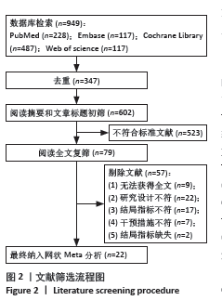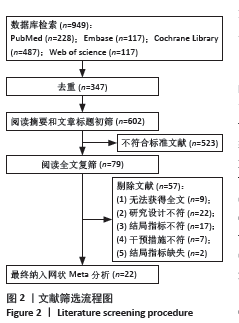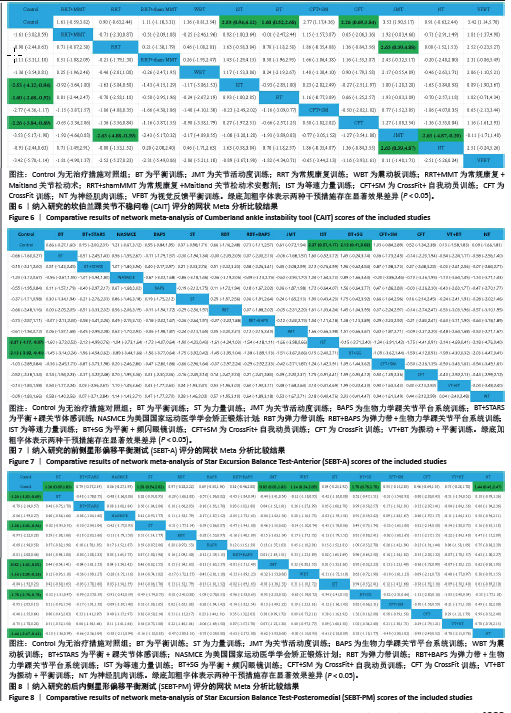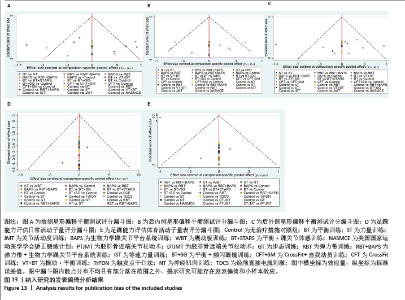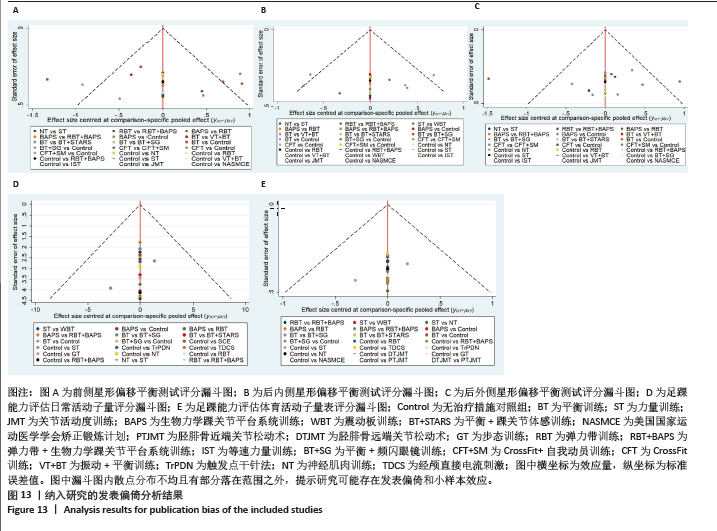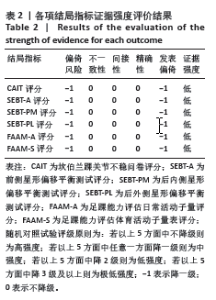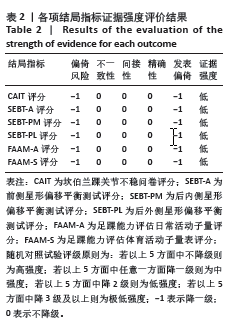Chinese Journal of Tissue Engineering Research ›› 2025, Vol. 29 ›› Issue (9): 1931-1944.doi: 10.12307/2025.162
Previous Articles Next Articles
Network meta-analysis of non-surgical treatments for foot and ankle ability and dynamic balance in patients with chronic ankle instability
Zhang Xinxin, Gao Ke, Xie Shidong, Tuo Haowen, Jing Feiyue, Liu Weiguo
- School of Physical Education and Health, Guangxi Normal University, Guilin 541004, Guangxi Zhuang Autonomous Region, China
-
Received:2024-03-06Accepted:2024-04-09Online:2025-03-28Published:2024-10-11 -
Contact:Liu Weiguo, Master, Professor, School of Physical Education and Health, Guangxi Normal University, Guilin 541004, Guangxi Zhuang Autonomous Region, China Jing Feiyue, Master, Associate professor, School of Physical Education and Health, Guangxi Normal University, Guilin 541004, Guangxi Zhuang Autonomous Region, China -
About author:Zhang Xinxin, PhD candidate, School of Physical Education and Health, Guangxi Normal University, Guilin 541004, Guangxi Zhuang Autonomous Region, China -
Supported by:Guangxi Philosophy and Social Sciences Research Project, No. 23BTY004 (to LWG); Innovation Project of Guangxi Graduate Education, No. XYCBZ2024014 (to ZXX)
CLC Number:
Cite this article
Zhang Xinxin, Gao Ke, Xie Shidong, Tuo Haowen, Jing Feiyue, Liu Weiguo. Network meta-analysis of non-surgical treatments for foot and ankle ability and dynamic balance in patients with chronic ankle instability[J]. Chinese Journal of Tissue Engineering Research, 2025, 29(9): 1931-1944.
share this article
Add to citation manager EndNote|Reference Manager|ProCite|BibTeX|RefWorks
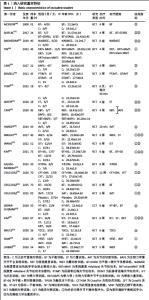
2.2 纳入研究基本特征和质量评价结果 文章共计纳入22项随机对照试验,共包括952例慢性踝关节不稳患者。治疗时长从20 min-12周不等。除2项研究以外,其他研究慢性踝关节不稳患者均为成年人。纳入研究共包括25种治疗方法,其中无治疗措施对照组(control)18项[20,22-23,26,28,39-45,47-48,50-53];平衡训练(balance training,BT)5项[22,27-28,42,51]; 力量训练(strength training,ST)3项[40,45,49];关节活动度训练(joint mobilizations training,JMT)[26,48];震动板训练(wobble board training,WBT)[49,53];常规康复训练(routine rehabilitation training,RRT)[19,40]; 生物力学踝关节平台系统训练(biomechanical ankle platform system,BAPS)2项[43,47]。除此之外,平衡+踝关节体感训练(BT+sensory-targeted ankle rehabilitation strategies training,BT+STARS)[27]、美国国家运动医学学会矫正锻炼计划(national academy of sport medicine corrective exercise program,NASMCE)[41]、常规康复+ Maitland关节松动术(RRT +maitland mobilization training,RRT+MMT)[19]、常规康复+Maitland关节松动术安慰剂(RRT+sham maitland mobilization training,RRT+sham MMT)[19]、胫腓骨近端关节松动术(proximal tibiofbular joint manipulation training,PTJMT)[44]、 胫腓骨远端关节松动术(distal tibiofbular joint manipulation training,DTJMT)[44]、步态训练(gait training,GT)[20]、弹力带训练(resistance band training,RBT)[47]、弹力带+生物力学踝关节平台系统训练(RBT+biomechanical ankle platform system training,RBT+BAPS)[47]、等速力量训练(isokinetic strength training,IST)[50]、平衡+频闪眼镜训练(BT+stroboscopic glasses,BT+SG)[51]、触发点干针法(trigger point dry needling,TrPDN)[52]、CrossFit+自我动员训练(crossfit training+self-mobilization,CFT+SM)[39]、CrossFit训练(crossfit training,CFT)[39]、振动+平衡训练(vibration training+BT,VT+BT)[22]、神经肌肉训练(neuromuscular training,NT)[40]、经颅直接电流刺激(transcranial direct current stimulation,TDCS)以及视觉反馈平衡训练(visual feedback balance training,VFBT)各1项[23,46]。结局指标方面,9项研究分析了CAIT评分[19,26,39,40,42,46,49-51],16项研究分析了SEBT评分[22,26-28,39-43,45,47-51,53],11项研究分析了FAAM评分[23,27,40-41,44-45,47,49,51-53]。纳入研究结果见表1。 文献质量评价结果显示,在随机分配方面,有6项研究存在不确定偏倚风险[27,43,45-46,49,52];在分配隐藏方面,13项研究存在不确定偏倚风险[19,26-28,43,45-46,48-53];在对研究者和受试者施盲方面,10项研究存在不确定偏倚风险[28,40-41,43,45-46,49-50,52-53],1项研究存在高偏倚风险[44];在研究结局的盲法评价方面,只有1项研究存在不确定偏倚风险[44];在选择性报告研究结果方面,有5项研究存在不确定偏倚风险[26,39,42,48,51];3项研究存在其他高偏倚风险[46,48,52], 16项存在不确定其他偏倚风险[19-20,22,26-28,40-41,43-45,47,49-51,53]。在总体文献质量评价方面,1项研究被评为低风险[23],8项研究被评为中风险[19,20,22,39-42,47],13项研究被评为高度风险[26-28,43-46,48-53]。研究结果见图3。 2.3 Meta分析证据网络 9项研究对CAIT评分进行了评估[19,26,39-40,42,46,49-51],共包含480例慢性踝关节不稳患者,形成3个闭合环;14项研究对SEBT-A评分进行了评估[22,26-28,39-43,45,47-48,50-51],共包含642例慢性踝关节不稳患者,形成6个闭合环;15项研究对SEBT-PM评分进行了评估[22,26-28,39-42,45,47-51,53],共包含709例慢性踝关节不稳患者,出现8个闭合环;14项研究对SEBT-PL评分进行了评估[22,26-28,39-43,45,47,48,50-51],共包含657例慢性踝关节不稳患者,出现7个闭合环;10项研究对FAAM-A评分进行了评估[20,23,27,40-41,45,47,49,51-52],共包含410例慢性踝关节不稳患者,出现5个闭合环;11项研究对FAAM-S评分进行了评估[20,23,27,40-41,44-45,47,49,51-52],共包含453例慢性踝关节不稳患者,出现6个闭合环。所有结局指标证据网络总体以对照组为中心形成相互比较,网状证据见图4。"
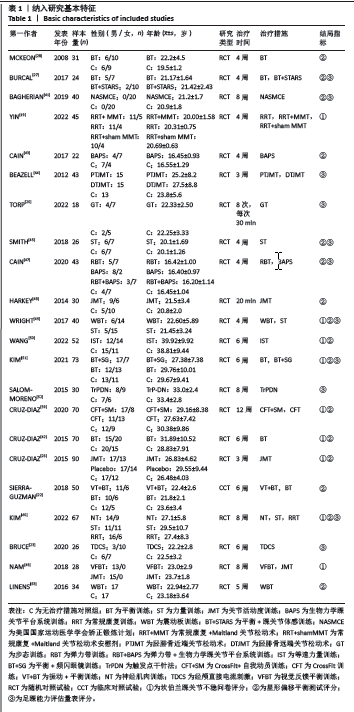
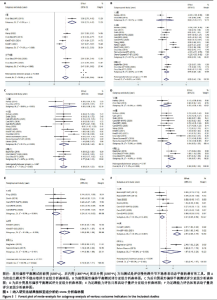
2.4 传统Meta分析结果 所有结局指标的传统Meta分析结果均表明,研究间异质性较高且以治疗时间为参数进行亚组分析后异质性仍然较高,因此仅对结果做描述性分析。研究结果表明,CAIT评分的传统Meta分析包含7种干预措施;SEBT-A、SEBT-PM和FAAM-S评分包含11种干预措施;SEBT-PL评分包含12种干预措施;FAAM-A评分包含9种干预措施。与对照组相比,所有干预措施均能显著提高CAIT评分,JMT,NASMCE,BAPS,ST,IST,CFT+SM,BT和BT+SG可以显著提高SEBT-A评分,JMT,NASMCE,RBT,BAPS,WBT,CFT+SM,VT+BT,BT和BT+SG能显著提高SEBT-PM评分,JMT,NASMCE,ST,RBT+BAPS,CFT+SM,CFT,IST,BT和BT+SG能显著提高SEBT-PL评分,NASMCE,TrPDN,BT和BT+SG可以显著提高FAAM-A和FAAM-S评分,研究结果,见图5。 2.5 网状Meta分析一致性模型评估结果 所有结局指标的全局不一致性检验(P > 0.05)及节点分裂法(P > 0.05)结果均显示一致性良好,故采用一致性模型进行网状Meta分析。网状Meta分析直接与间接比较结果表明,与对照组相比,IST,BT和CFT显著改善了CAIT评分(P < 0.05);IST和BT+SG显著改善了SEBT-A评分(P < 0.05);BT,ST,JMT,WBT,BT+SG和NT显著改善了SEBT-PM评分(P < 0.05);BT,BT+SG和CFT+SM显著改善了SEBT-PL评分(P < 0.05);BT,NASMCE,ST,WBT,BT+SG,TrPDN和NT显著改善了FAAM-A评分(P < 0.05);ST,TrPDN和NT显著改善了FAAM-S评分(P < 0.05)。与RRT相比,JMT显著改善了CAIT评分;与NT相比,JMT显著改善了CAIT评分(P < 0.05);与NASMCE相比,GT,ST,RBT,BAPS,RBT+BAPS和TDCS显著降低了FAAM-A评分(P < 0.05);与GT相比,BT+SG显著改善了FAAM-A和FAAM-S评分(P < 0.05),WBT显著改善了FAAM-S评分(P < 0.05)。与RBT相比,BT+SG显著改善了FAAM-A评分(P < 0.05),WBT显著改善了FAAM-S评分;与BAPS相比,BT+SG和WBT显著改善了FAAM-A评分(P < 0.05),WBT和NT显著改善了FAAM-S评分(P < 0.05);与RBT相比,WBT显著改善了FAAM-A评分(P < 0.05);与TDCS相比,BT+SG显著改善了FAAM-A评分(P < 0.05);与BT相比,GT,ST,RBT,TrPDN和NT显著降低了FAAM-S评分(P < 0.05);与BT+STARS相比,DTJMT,GT,RBT,RBT+BAPS,TrPDN和TDCS显著降低了FAAM-S评分(P < 0.05);与NASMCE相比,GT,RBT,RBT+BAPS,TrPDN和NT显著降低了FAAM-S评分(P < 0.05);与PTJMT和DTJMT相比,ST,WBT和NT显著改善了FAAM-S评分(P < 0.05);与ST相比,RBT,BAPS,RBT+BAPS和TDCS显著降低了FAAM-S评分(P < 0.05),BT+SG显著改善了FAAM-S评分(P < 0.05);与RBT+BAPS相比,WBT显著 改善了FAAM-S评分(P < 0.05);与WBT相比,NT和TDCS显著降低了FAAM-S评分(P < 0.05)。具体研究结果如图6-11所示。"
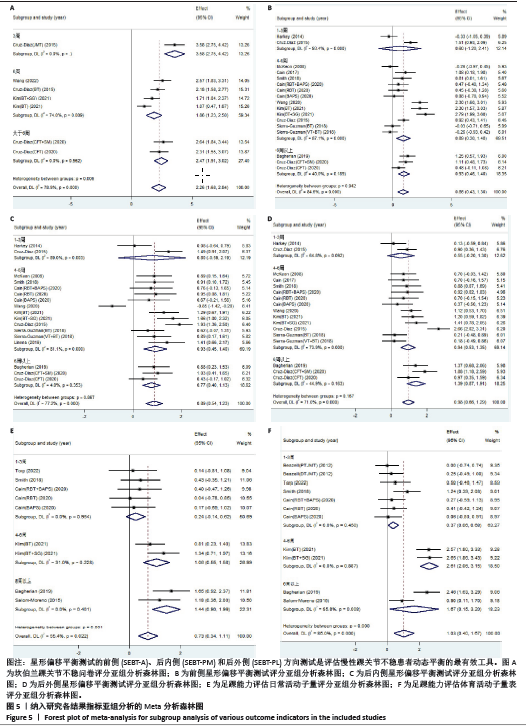
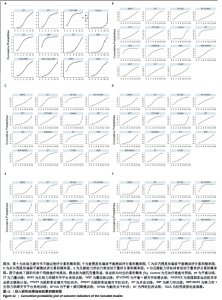
图12展示了基于累积概率图的治疗效果排序。结果表明CAIT评分最有效的3种治疗方法为JMT(88.6%),VFBT(83.1%)和CFT+SM(74.8%);SEBT-A评分最有效的3种治疗方法为JMT(88.4%),IST(86.9%)和NASMCE(65.0%);SEBT-PM评分最有效的3种治疗方法为BT+SG(87.4%),NT(74.6%)和ST(68.9%);SEBT-PL评分最有效的3种治疗方法为CFT+SM(74.6%),BT+SG(70.0%)和NT(63.7%);FAAM-A评分最有效的3种治疗方法为NASMCE(91.9%),BT+SG(85.6%)和WBT(82.2%);FAAM-S评分最有效的3种治疗方法为BT+ SG(93.5%),BT(86.7%)和NASMCE(86.4%)。"
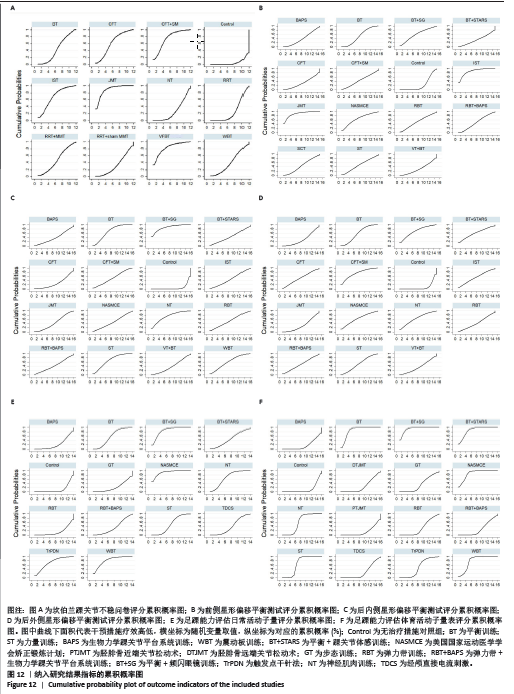
| [1] HOOTMAN JM, DICK R, AGEL J. Epidemiology of collegiate injuries for 15 sports: summary and recommendations for injury prevention initiatives. J Athl Train. 2007;42(2):311-319. [2] NELSON AJ, COLLINS CL, YARD EE, et al. Ankle injuries among United States high school sports athletes, 2005-2006. J Athl Train. 2007;42(3):381-387. [3] 苏玉莹,李卫,石煜,等.不同运动干预改善慢性踝关节不稳症状和动态平衡能力的元分析[J].中国组织工程研究,2024, 28(32):5217-5224. [4] 王子龙,孟昕,张芷棋,等.功能性踝关节不稳男性下蹲跳过程中下肢的生物力学特征[J].中国组织工程研究,2025, 29(3):478-485. [5] SOBOROFF SH, PAPPIUS EM, KOMAROFF AL. Benefits, risks, and costs of alternative approaches to the evaluation and treatment of severe ankle sprain. Clin Orthop Relat Res. 1984;(183):160-168. [6] HUBBARD TJ, KRAMER LC, DENEGAR CR, et al. Correlations among multiple measures of functional and mechanical instability in subjects with chronic ankle instability. J Athl Train. 2007;42(3):361-366. [7] WITCHALLS J, BLANCH P, WADDINGTON G, et al. Intrinsic functional deficits associated with increased risk of ankle injuries: a systematic review with meta-analysis. Br J Sports Med. 2012;46(7):515-523. [8] GRIBBLE PA, DELAHUNT E, BLEAKLEY C, et al. Selection criteria for patients with chronic ankle instability in controlled research: a position statement of the International Ankle Consortium. J Orthop Sports Phys Ther. 2013;43(8):585-591. [9] TSIKOPOULOS K, MAVRIDIS D, GEORGIANNOS D, et al. Does multimodal rehabilitation for ankle instability improve patients’ self-assessed functional outcomes? A Network Meta-analysis. Clin Orthop Relat Res. 2018;476(6):1295-1310. [10] 尹贻锟,王佳林,伍朝明,等.关节松动治疗慢性踝关节不稳功能恢复的荟萃分析[J].中国组织工程研究,2022,26(33): 5407-5412. [11] 何伟,梁吉东.踝关节融合术联合富血小板血浆注射治疗足踝创伤性关节炎临床疗效[J].山西医药杂志,2022,51(21):2447-2449. [12] 贾光辉,方永刚,王翔宇.持续被动训练对慢性踝关节外侧不稳患者术后踝关节功能恢复的影响[J].中华物理医学与康复杂志,2020,42(7):648-650. [13] 纵华琛,姜财,郭进华,等.本体感觉训练方式在慢性踝关节不稳的治疗进展[J].中国康复,2023,38(11):697-700. [14] 任艺,王蕊,章耀华.本体感觉神经肌肉促进技术联合神经肌肉电刺激对慢性踝关节不稳的效果[J].中国康复理论与实践,2023,29(7):750-755. [15] 苏玉莹,彭亮,李卫,等.整合性神经肌肉训练对慢性踝关节不稳康复与预防的研究进展[J].中国体育科技,2023,59(7): 47-52. [16] 于歌,王璐,陈亚平.全身振动训练对慢性踝关节不稳姿势稳定性影响的Meta分析[J].中国康复理论与实践,2023,29(4): 423-432. [17] HAN J, LUAN L, ADAMS R, et al. Can therapeutic exercises improve proprioception in chronic ankle instability? A systematic review and network meta-analysis. Arch Phys Med Rehabil. 2022;103(11):2232-2244. [18] TSIKOPOULOS K, MAVRIDIS D, GEORGIANNOS D, et al. Efficacy of non-surgical interventions on dynamic balance in patients with ankle instability: a network meta-analysis. J Sci Med Sport. 2018;21(9): 873-879. [19] YIN Y, YU Z, WANG J, et al. Effectiveness of the rehabilitation training combined with maitland mobilization for the treatment of chronic ankle instability: a randomized controlled trial. Int J Environ Res Public Health. 2022;19(22):15328. [20] TORP DM, THOMAS AC, HUBBARD-TURNER T, et al. Effects of gait training with auditory biofeedback on biomechanics and talar cartilage characteristics in individuals with chronic ankle instability: a randomized controlled trial. Gait Posture. 2022;95:1-8. [21] 宝金才,张秀花,王志,等.应用BTE Primus RS和三维步态分析技术治疗踝关节功能障碍[J].湖南师范大学学报(医学版),2018,15(5):55-59. [22] SIERRA-GUZMAN R, JIMENEZ-DIAZ F, RAMIREZ C, et al. Whole-body-vibration training and balance in recreational athletes with chronic ankle instability. J Athl Train. 2018;53(4):355-363. [23] BRUCE AS, HOWARD JS, VAN WH, et al. The effects of transcranial direct current stimulation on chronic ankle instability. Med Sci Sports Exerc. 2020;52(2):335-344. [24] 王宝峰,肖松林,张希妮,等.经颅直流电刺激联合运动干预对运动能力影响的研究进展[J].体育科研,2022,43(1):21-27. [25] HUTTON B, SALANTI G, CALDWELL DM, et al. The PRISMA extension statement for reporting of systematic reviews incorporating network meta-analyses of health care interventions: checklist and explanations. Ann Intern Med. 2015; 162(11):777-784. [26] CRUZ-DÍAZ D, LOMAS VR, OSUNA-PéREZ MC, et al. Effects of joint mobilization on chronic ankle instability: a randomized controlled trial. Disabil Rehabil. 2015; 37(7):601-610. [27] BURCAL CJ, TRIER AY, WIKSTROM EA. Balance training versus balance training with stars in patients with chronic ankle instability: a randomized controlled trial. J Sport Rehabil. 2017;26(5):347-357. [28] MCKEON PO, INGERSOLL CD, KERRIGAN DC, et al. Balance training improves function and postural control in those with chronic ankle instability. Med Sci Sports Exerc. 2008;40(10):1810-1819. [29] HIGGINS JP, ALTMAN DG, GøTZSCHE PC, et al. The Cochrane Collaboration’s tool for assessing risk of bias in randomised trials. BMJ. 2011;343:d5928. [30] DE OLIVEIRA PCA, DE ARAÚJO TAB, MACHADO D, et al. Transcranial direct current stimulation on parkinson’s disease: systematic review and meta-analysis. Front Neurol. 2022;12:794784. [31] CUMPSTON M, LI T, PAGE MJ, et al. Updated guidance for trusted systematic reviews: a new edition of the cochrane handbook for systematic reviews of interventions. Cochrane Database Syst Rev. 2019;10(10):ED000142. [32] 刘壮,高奉,朱婷,等.减重训练对前交叉韧带重建术后患者临床疗效的系统评价与Meta分析[J].体育科学,2023,43(3): 78-88, 97. [33] 郝莹,陈卓.抗阻运动提升老年人下肢肌肉力量及功能状态的网状Meta分析[J].中国循证医学杂志,2024,24(2):175-182. [34] ZHANG X, JING F, LIU Y, et al. Effects of non-invasive brain stimulation on walking and balance ability in Parkinson’s patients: a systematic review and meta-analysis. Front Aging Neurosci. 2023;14:1065126. [35] 尹润宇,杨东元,王世坤,等.补肾活血类中成药治疗膝骨性关节炎的有效性和安全性网状Meta分析[J].中草药, 2023,54(13):4266-4277. [36] 邓通,汪洋,黄笛,等.临床实践指南制订方法——GRADE方法理论篇[J].中国循证心血管医学杂志,2018,10(12): 1441-1445,1449. [37] 王琪,王建成,潘蓓,等.网状Meta分析证据质量分级:GRADE方法学前沿与进展[J].中国循证医学杂志, 2020,20(8): 979-985. [38] 王贺,韩靓,阚梦凡,等.电刺激治疗脑卒中后肩手综合征有效性的系统评价与Meta分析[J].中国康复理论与实践,2023, 29(9):1048-1056. [39] CRUZ-DIAZ D, HITA-CONTRERAS F, MARTINEZ-AMAT A, et al. Ankle-joint self-mobilization and crossfit training in patients with chronic ankle instability: a randomized controlled trial. J Athl Train. 2020;55(2): 159-168. [40] KIM KM, ESTEPA-GALLEGO A, ESTUDILLO-MARTíNEZ MD, et al. Comparative effects of neuromuscular- and strength-training protocols on pathomechanical, sensory-perceptual, and motor-behavioral impairments in patients with chronic ankle instability: randomized controlled trial. Healthcare (Basel). 2022;10(8):1364. [41] BAGHERIAN S, RAHNAMA N, WIKSTROM EA. Corrective exercises improve movement efficiency and sensorimotor function but not fatigue sensitivity in chronic ankle instability patients: a randomized controlled trial. Clin J Sport Med. 2019;29(3):193-202. [42] CRUZ-DIAZ D, LOMAS-VEGA R, OSUNA-PEREZ MC, et al. Effects of 6 weeks of balance training on chronic ankle instability in athletes: a randomized controlled trial. Int J Sports Med. 2015;36(9):754-760. [43] CAIN MS, GARCEAU SW, LINENS SW. Effects of a 4-week biomechanical ankle platform system protocol on balance in high school athletes with chronic ankle instability. J Sport Rehabil. 2017;26(1):1-7. [44] BEAZELL JR, GRINDSTAFF TL, SAUER LD, et al. Effects of a proximal or distal tibiofibular joint manipulation on ankle range of motion and functional outcomes in individuals with chronic ankle instability. J Orthop Sports Phys Ther. 2012;42(2): 125-134. [45] SMITH BI, CURTIS D, DOCHERTY CL. Effects of hip strengthening on neuromuscular control, hip strength, and self-reported functional deficits in individuals with chronic ankle instability. J Sport Rehabil. 2018;27(4):364-370. [46] NAM SM, KIM K, LEE DY. Effects of visual feedback balance training on the balance and ankle instability in adult men with functional ankle instability. J Phys Ther Sci. 2018;30(1):113-115. [47] CAIN MS, BAN RJ, CHEN YP, et al. Four-week ankle-rehabilitation programs in adolescent athletes with chronic ankle instability. J Athl Train. 2020;55(8):801-810. [48] HARKEY M, MCLEOD M, VAN SA, et al. The immediate effects of an anterior-to-posterior talar mobilization on neural excitability, dorsiflexion range of motion, and dynamic balance in patients with chronic ankle instability. J Sport Rehabil. 2014;23(4):351-359. [49] WRIGHT CJ, LINENS SW, CAIN MS. A randomized controlled trial comparing rehabilitation efficacy in chronic ankle instability. J Sport Rehabil. 2017;26(4): 238-249. [50] WANG B, ZHANG X, ZHU F, et al. A randomized controlled trial comparing rehabilitation with isokinetic exercises and Thera-Band strength training in patients with functional ankle instability. PLoS One. 2022;17(12):e0278284. [51] KIM KM, ESTUDILLO-MARTíNEZ MD, CASTELLOTE-CABALLERO Y, et al. Short-term effects of balance training with stroboscopic vision for patients with chronic ankle instability: a single-blinded randomized controlled trial. Int J Environ Res Public Health. 2021; 18(10):5364. [52] SALOM-MORENO J, AYUSO-CASADO B, TAMARAL-COSTA B, et al. Trigger point dry needling and proprioceptive exercises for the management of chronic ankle instability: a randomized clinical trial. Evid Based Complement Alternat Med. 2015; 2015:790209. [53] LINENS SW, ROSS SE, ARNOLD BL. Wobble board rehabilitation for improving balance in ankles with chronic instability. Clin J Sport Med. 2016;26(1):76-82. [54] KOSIK KB, MCCANN RS, TERADA M, et al. Therapeutic interventions for improving self-reported function in patients with chronic ankle instability: a systematic review. Br J Sports Med. 2017;51(2):105-112. [55] MAZAHERI M, SALAVATI M, NEGAHBAN H, et al. Reliability and validity of the Persian version of Foot and Ankle Ability Measure (FAAM) to measure functional limitations in patients with foot and ankle disorders. Osteoarthritis Cartilage. 2010;18(6): 755-759. [56] SHIH YF, YU HT, CHEN WY, et al. The effect of additional joint mobilization on neuromuscular performance in individuals with functional ankle instability. Phys Ther Sport. 2018;30:22-28. [57] 刘丽华,王芳,张燕华,等.基于增强现实技术的体感互动游戏在慢性心力衰竭患者康复训练中的应用效果研究[J].实用心脑肺血管病杂志,2022,30(5): 15-19. [58] KINZEY SJ, ARMSTRONG CW. The reliability of the star-excursion test in assessing dynamic balance. J Orthop Sports Phys Ther. 1998;27(5):356-360. [59] RIEMANN BL, LEPHART SM. The sensorimotor system, Part II: the role of proprioception in motor control and functional joint stability. J Athl Train. 2002; 37(1):80-84. [60] LI Y, TSANG RC, LIU D, et al. Applicability of cutoff scores of chinese cumberland ankle instability tool and foot and ankle ability measure as inclusion criteria for study of chronic ankle instability in chinese individuals. Phys Ther Sport. 2021;48: 116-120. [61] DONAHUE M, SIMON J, DOCHERTY CL. Critical review of self-reported functional ankle instability measures. Foot Ankle Int. 2011;32(12):1140-1146. [62] ROSEN AB, JOHNSTON M, CHUNG S, et al. The reliability and validity of a digital version of the Cumberland Ankle Instability Tool. Disabil Rehabil. 2021;43(12): 1738-1741. |
| [1] | Zhu Xiaoxue, Zhao Qiongqiu, Zhang Teng, Wang Dan, Qiu Jihong, Song Qipeng, Shen Peixin. Increasing toe-out angle during drop-landing can diminish risk of inversion injuries among individuals with chronic ankle instability [J]. Chinese Journal of Tissue Engineering Research, 2025, 29(9): 1827-1833. |
| [2] | Wang Juan, Wang Guanglan, Zuo Huiwu. Efficacy of exercise therapy in the treatment of anterior cruciate ligament reconstruction patients: #br# a network meta-analysis #br# [J]. Chinese Journal of Tissue Engineering Research, 2025, 29(8): 1714-1726. |
| [3] | Wu Yihan, Liu Zhongqiang, Wei Qiaoye, Liu Mingdong, Chen Keyi, Li Zhigang. Effect of balance training with different visual conditions on proprioception in patients with chronic ankle instability [J]. Chinese Journal of Tissue Engineering Research, 2025, 29(5): 1050-1057. |
| [4] | Li Zhe, Li Ping, Zhang Chao, Guo Guangling. A network meta-analysis of efficacy of mesenchymal stem cells from different sources in treatment of premature ovarian failure animal models [J]. Chinese Journal of Tissue Engineering Research, 2025, 29(36): 7898-7908. |
| [5] | Tian Jinxin, Zhao Yuxin, Hu Tong, Cui Tiantian, Ma Lihong. Effects of different transcranial magnetic stimulation modes on refractory depression in adults: a network meta-analysis [J]. Chinese Journal of Tissue Engineering Research, 2025, 29(35): 7639-7648. |
| [6] | Wang Kaigang, Hao Dongsheng, Ma Pei, Zhou Shuo, Li Ruimin. Comparison of efficacy of different biological scaffolds for pulp regeneration therapy in immature permanent teeth: a Bayesian network meta-analysis [J]. Chinese Journal of Tissue Engineering Research, 2025, 29(34): 7447-7460. |
| [7] | Guo Ping, Wang Juan. Bilateral lower limb biomechanical abnormalities in patients with unilateral chronic ankle instability [J]. Chinese Journal of Tissue Engineering Research, 2025, 29(32): 6920-6926. |
| [8] | Li Jia, Liu Qianru, Xing Mengnan, Chen Bo, Jiao Wei, Meng Zhaoxiang. A network meta-analysis on therapeutic effect of different types of exercise on knee osteoarthritis patients [J]. Chinese Journal of Tissue Engineering Research, 2025, 29(3): 609-616. |
| [9] | Zhao Yuxin, Zhang Deqi, Bi Hongyan. Effect of different stimulation modalities of non-invasive brain stimulation on cognitive function in patients with Parkinson’s disease: a network Meta-analysis [J]. Chinese Journal of Tissue Engineering Research, 2025, 29(24): 5212-5223. |
| [10] | Hu Tong, Li Xuan, Yuan Jing, Wang Wei. Different electromagnetic stimulation programs improve post-stroke dysphagia: a network Meta-analysis [J]. Chinese Journal of Tissue Engineering Research, 2025, 29(24): 5224-5236. |
| [11] | Li Yuanfeng, Ye Pufeng, Pan Guifeng, Mai Zhenjiang. Dose-effect relationship between dexmedetomidine and ropivacaine during pericapsular nerve group block in elderly patients undergoing total hip arthroplasty [J]. Chinese Journal of Tissue Engineering Research, 2025, 29(21): 4514-4520. |
| [12] | Liu Xingzhao, Hu Tong, Ma Yan, Wang Qian, Wei Xiaohui, Chang Wanpeng, Yu Shaohong. Efficacy of rehabilitation robots on lower limb motor function in patients with cerebral palsy: a Meta-analysis [J]. Chinese Journal of Tissue Engineering Research, 2025, 29(18): 3925-3933. |
| [13] | Liu Yanhao, Dong Shiyu, Liu Ziyin, Song Qipeng, Shen Peixin. Unilateral chronic ankle instability affects bilateral postural stability, proprioception, plantar tactile sensation and muscle strength [J]. Chinese Journal of Tissue Engineering Research, 2025, 29(17): 3572-3578. |
| [14] | Liu Qing, Ma Gang, Cao Jianling, Zhang Yu, Xiong You, He Ruibo. Effects of different types of taping on ankle joint kinesiology during walking in patients with chronic ankle instability [J]. Chinese Journal of Tissue Engineering Research, 2025, 29(14): 2989-2994. |
| [15] | Zhong Jun, Wang Wen. Network meta-analysis of different anatomical repair strategies to improve chronic lateral ankle instability [J]. Chinese Journal of Tissue Engineering Research, 2024, 28(9): 1470-1476. |
| Viewed | ||||||
|
Full text |
|
|||||
|
Abstract |
|
|||||
